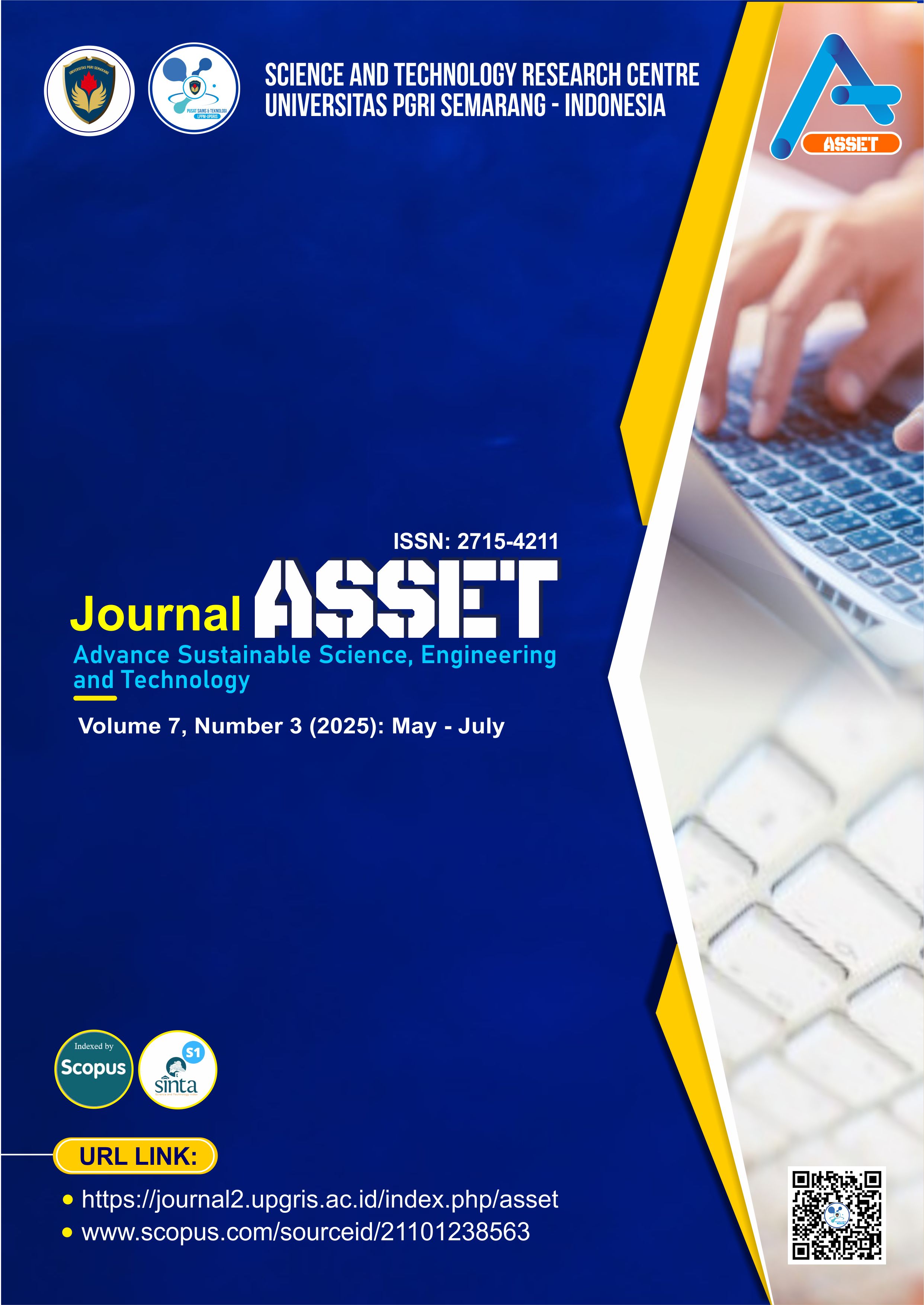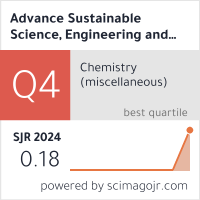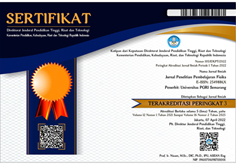Synthesis of Silica Gel From Rice Husk Ash for Sustainable Air Conditioning Requirements
DOI:
https://doi.org/10.26877/asset.v7i4.1944Keywords:
desiccant, rice husk ash, silica gel, adsorption, air conditioning, Sustainable /RenewableAbstract
An increase in air conditioning demand, driven by global warming and the need for comfort, highlights the importance of energy-efficient systems like desiccant cooling. This research explores using rice husk ash (RHA), an agricultural waste product from Indonesia, to synthesize silica gel for these systems. The study involved synthesizing silica gel from RHA through chemical processes and comparing its sorption capacity to commercial silica gel. Two synthesis methods were tested: a direct reaction of water glass with acid compounds and an impregnation process on honeycomb walls. The results indicate that the direct reaction method produces a silica gel with better pore performance. Ultimately, the study found that RHA from West Java, Indonesia, is a viable raw material for desiccant air conditioning, although its sorption capacity is slightly lower than that of commercial silica gel. This offers a valuable use for agricultural waste.
References
[1] R. P. Singh, V. K. Mishra, and R. K. Das, “Desiccant materials for air conditioning applications - A review,” IOP Conf. Ser. Mater. Sci. Eng., vol. 404, no. 1, 2018, doi: 10.1088/1757-899X/404/1/012005
[2] O. Amer, R. Boukhanouf, and H. G. Ibrahim, “A Review of Evaporative Cooling Technologies,” Int. J. Environ. Sci. Dev., vol. 6, no. 2, pp. 111–117, 2015, doi: 10.7763/ijesd.2015.v6.571.
[3] M. M. Rafique, “Investigation of a solar assisted thermally activated air conditioning system,” 2015, MS Thesis in Mechanical Engineering, King Fahd University of Petroleum and ….
[4] A. Sur, “Analysis of an Evaporative Desiccant Cooling System Adsorption Refrigeration System View project Micro-lattice structures for heat transfer applications View project Analysis of an Evaporative Desiccant Cooling System,” J. Refrig. Air Cond. Heat. Vent., vol. 2, no. 2, pp. 31–38, 2015, [Online]. Available: www.stmjournals.com
[5] F. Firmansyah, M. Yusuf, and T. O. Argarini, “hasil perbaikan penghitungan luas panen dengan menggunakan metode Kerangka Sampel Area (KSA),” J. Penataan Ruang, vol. 16, no. 1, p. 47, 2021.
[6] H. Lubis, “Renewable Energy of Rice Husk for Reducing Fossil Energy in Indonesia,” J. Adv. Res. Appl. Sci. Eng. Technol., vol. 11, no. 1, pp. 17–22, 2018, [Online]. Available: https://www.akademiabaru.com/submit/index.php/araset/article/view/1953
[7] P. N. Babaso and H. Sharanagouda, “Rice Husk and Its Applications: Review,” Int. J. Curr. Microbiol. Appl. Sci., vol. 6, no. 10, pp. 1144–1156, 2017, doi: 10.20546/ijcmas.2017.610.138.
[8] L. Vinet and A. Zhedanov, “A ‘missing’ family of classical orthogonal polynomials,” J. Phys. A Math. Theor., vol. 44, no. 8, pp. 1–14, 2011, doi: 10.1088/1751-8113/44/8/085201.
[9] X. N. Wu, T. S. Ge, Y. J. Dai, and R. Z. Wang, “Investigation on novel desiccant wheel using wood pulp fiber paper with high coating ratio as matrix,” Energy, vol. 176, pp. 493–504, 2019, doi: 10.1016/j.energy.2019.04.006.
[10] J. White, “CFD simulation of silica gel and water adsorbent beds used in adsorption cooling system,” Phd Thesis, Birmigham City Univ., p. 210, 2012.
[11] K. C. Ng et al., “Experimental investigation of the silica gel-water adsorption isotherm characteristics,” Appl. Therm. Eng., vol. 21, no. 16, pp. 1631–1642, 2001, doi: 10.1016/S1359-4311(01)00039-4.
[12] R. Narayanan, “Theoretical Modelling of Silica Gel Desiccant Wheels,” Appl. Mech. Mater., vol. 787, no. May, pp. 311–317, 2015, doi: 10.4028/www.scientific.net/amm.787.311.
[13] C. H. Chen, C. Y. Hsu, C. C. Chen, and S. L. Chen, “Silica gel polymer composite desiccants for air conditioning systems,” Energy Build., vol. 101, pp. 122–132, 2015, doi: 10.1016/j.enbuild.2015.05.009.
[14] X. Zheng, T. S. Ge, and R. Z. Wang, “Recent progress on desiccant materials for solid desiccant cooling systems,” Energy, vol. 74, no. 1, pp. 280–294, 2014, doi: 10.1016/j.energy.2014.07.027.
[15] K. Lazaar, W. Hajjaji, R. C. Pullar, J. A. Labrincha, F. Rocha, and F. Jamoussi, “Production of silica gel from Tunisian sands and its adsorptive properties,” J. African Earth Sci., vol. 130, no. March, pp. 238–251, 2017, doi: 10.1016/j.jafrearsci.2017.03.017.
[16] I. J. Fernandes et al., “Characterization of silica produced from rice husk ash: Comparison of purification and processing methods,” Mater. Res., vol. 20, pp. 519–525, 2017, doi: 10.1590/1980-5373-mr-2016-1043.
[17] M. Besbes, N. Fakhfakh, and M. Benzina, “Characterization of silica gel prepared by using sol-gel process,” Phys. Procedia, vol. 2, no. 3, pp. 1087–1095, 2009, doi: 10.1016/j.phpro.2009.11.067.
[18] X. Ma et al., “A recyclable method for production of pure silica from rice hull ash,” Powder Technol., vol. 217, pp. 497–501, 2012, doi: 10.1016/j.powtec.2011.11.009.
[19] U. Kalapathy, A. Proctor, and J. Shultz, “A simple method for production of pure silica from rice hull ash,” Bioresour. Technol., vol. 73, no. 3, pp. 257–262, 2000, doi: 10.1016/S0960-8524(99)00127-3.
[20] M. Goldsworthy and S. White, “Optimisation of a desiccant cooling system design with indirect evaporative cooler,” Int. J. Refrig., vol. 34, no. 1, pp. 148–158, 2011, doi: 10.1016/j.ijrefrig.2010.07.005.
[21] P. Balthazar, M. A. Ismail, M. N. M. Nasir, H. Mamat, and M. I. Ramdan, “Experimental investigation on a desiccant silica bed for dehumidification,” J. Adv. Res. Fluid Mech. Therm. Sci., vol. 73, no. 2, pp. 1–11, 2020, doi: 10.37934/ARFMTS.73.2.111.
[22] U. Kalapathy, A. Proctor, and J. Shultz, “Production and properties of flexible sodium silicate films from rice hull ash silica,” Bioresour. Technol., vol. 72, no. 2, pp. 99–106, 2000, doi: 10.1016/S0960-8524(99)00112-1.
[23] D. A. Wulandari, Nasruddin, and E. Djubaedah, “Selectivity of water adsorbent characteristic on natural zeolite in cooling application,” J. Adv. Res. Fluid Mech. Therm. Sci., vol. 55, no. 1, pp. 111–118, 2019.
[24] T. L. Chew, C. K. Choy, Y. F. Yeong, J. W. Lim, A. L. Ahmad, and C. D. Ho, “Mesoporous materials synthesized by novel reflux synthesis method,” J. Adv. Res. Fluid Mech. Therm. Sci., vol. 47, no. 1, pp. 151–158, 2018.
[25] M. Thommes et al., “Physisorption of gases, with special reference to the evaluation of surface area and pore size distribution (IUPAC Technical Report),” Pure Appl. Chem., vol. 87, no. 9–10, pp. 1051–1069, 2015, doi: 10.1515/pac-2014-1117.











